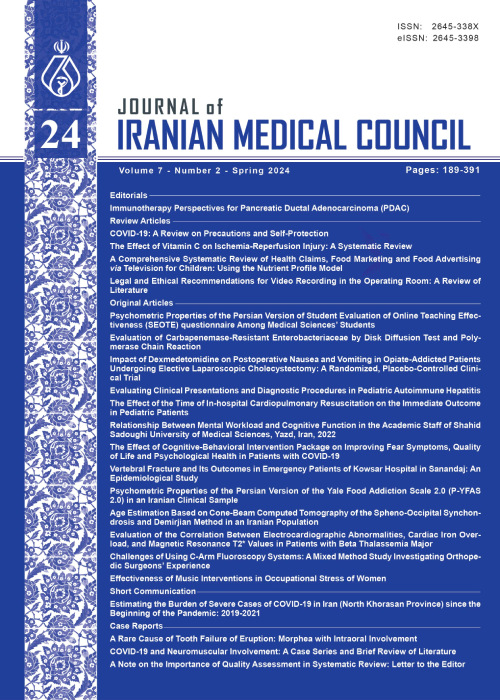A Protocol for Diagnosis, Care and Treatment of HIV, Hepatitis C and Tuberculosis in Residential Centers of Tehran, Iran
Author(s):
Article Type:
Research/Original Article (دارای رتبه معتبر)
Abstract:
Background
People living in temporary residential centers such as camps and shelters for a short period of time (from one day up to 6 months) are more likely to be infected with HIV, Hepatitis B and C and Tuberculosis because of their high risk behaviours. Therefore, screening and identification of people with these diseases can help cure and prevent the spread of the said diseases in the society. These centers have made intermittent efforts to diagnose and treat their clients. However, to improve the services rendered to these people in the areas of HIV/AIDS, hepatitis C and tuberculosis, we have tried to establish an exhaustive unified protocol for these centers in order to be used as a guideline for diagnosis, treatment and care and follow–up upon the patients´ discharge. Methods
In order to implement the project with the aim of diagnosing and connecting to treatment, the centers first reported on the measures taken so far and interviews were conducted with the authorities, staff and clients of said centers. After reviewing the existing protocols at these centers, examining the strengths and weaknesses of the centers and the facilities and processes they use to diagnose, treat, and in particular to follow-up after the patient is discharged – to make sure the patients continue treatment and adhere to medications; training sessions were held at the centers whereby each of the administrative and health staff and clients were individually provided with the necessary training in prevention, diagnosis and treatment and they were assigned some tasks in line with the project objectives.Results
Based on the training, we developed a model that identifies the role of everyone (client, administrative staff, health care personnel and physicians) in the process of the project and all of its different phases and stages which can be used as an unified and practical protocol at all of the target centers. In this model, the stages of diagnosis, screening, testing, accessing treatment clinics, receiving medication, how to use the medicines while staying in the centers, as well as follow-up and adherence to treatment up to one year after discharge were considered. Conclusion
Due to the problems in the operating system of these centers, the protocol intended to not only make the diagnosis and treatment process more accurate but also pay close attention to adherence to the treatment and connection to the treatment centers and guidelines after the client is discharged.Keywords:
hepatitis , HIV , Linkage , protocol , Residential centers , Tuberculosis
Language:
English
Published:
Journal of Iranian Medical Council, Volume:3 Issue: 1, Winter 2020
Pages:
9 to 22
magiran.com/p2142103
دانلود و مطالعه متن این مقاله با یکی از روشهای زیر امکان پذیر است:
اشتراک شخصی
با عضویت و پرداخت آنلاین حق اشتراک یکساله به مبلغ 1,390,000ريال میتوانید 70 عنوان مطلب دانلود کنید!
اشتراک سازمانی
به کتابخانه دانشگاه یا محل کار خود پیشنهاد کنید تا اشتراک سازمانی این پایگاه را برای دسترسی نامحدود همه کاربران به متن مطالب تهیه نمایند!
توجه!
- حق عضویت دریافتی صرف حمایت از نشریات عضو و نگهداری، تکمیل و توسعه مگیران میشود.
- پرداخت حق اشتراک و دانلود مقالات اجازه بازنشر آن در سایر رسانههای چاپی و دیجیتال را به کاربر نمیدهد.
In order to view content subscription is required
Personal subscription
Subscribe magiran.com for 70 € euros via PayPal and download 70 articles during a year.
Organization subscription
Please contact us to subscribe your university or library for unlimited access!


